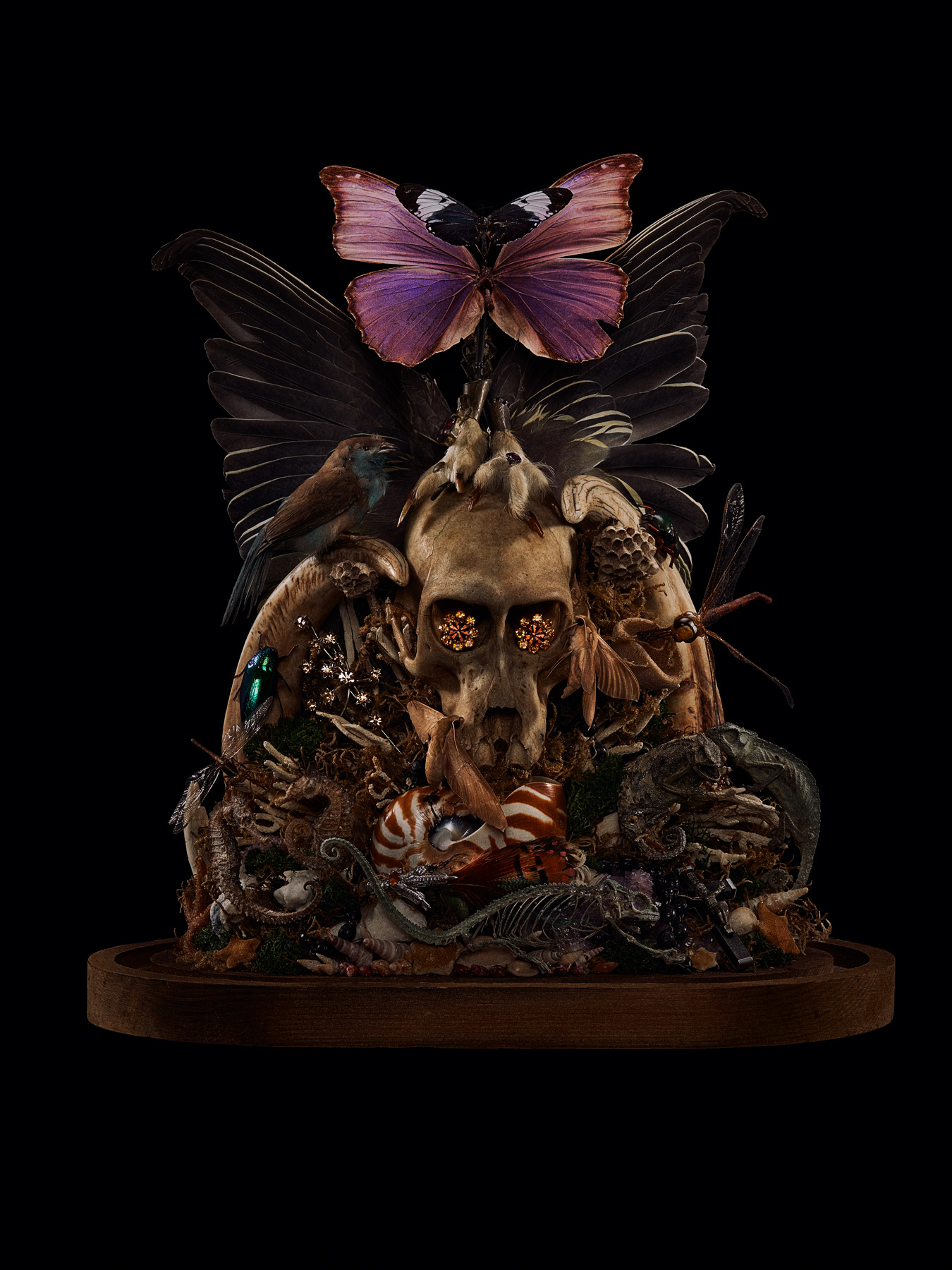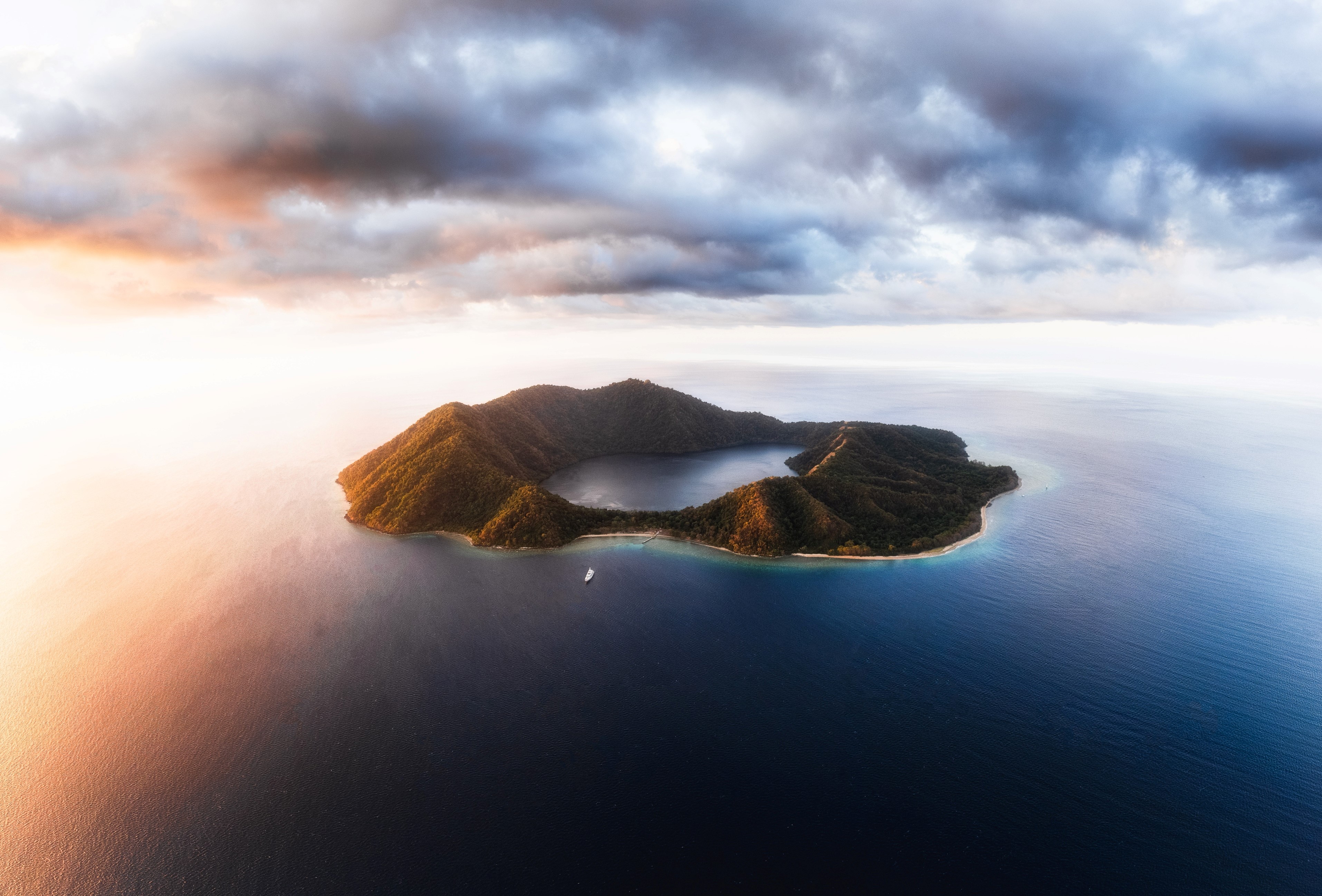Raised in a funeral home located in the province formerly known as the Transvaal by a family of undertakers, artist Wim van Zyl discovered the otherworldly beauty in death at a young age. He spent the entirety of his life to date collecting small objects of personal significance — some gifted by friends and family, some discovered in markets, some seemingly placed directly into his hands by the Universe itself. There were the skulls of dead animals, a candelabra, earrings from his grandmother, all gathered together without Wim being sure why he was accumulating these seemingly unrelated fragments of a life lived by himself and others.
It was during his self-described “midlife crisis” that Wim started to connect the dots. In the murkiness of questioning, he found himself driven to craft something that expressed all that he was experiencing: the earnest seeking for true comprehension, the desperate longing for a personal death and rebirth.
Wim began assembling his collections of objects into two magnificent artworks that would eventually form his debut Tabernacle of Memories sculpture series. The pieces are both an ode to the passing of his former self and celebration and honouring of the new expression of identity he is crafting, having emerged from his time in the chrysalis of his personal crisis as a creature born entirely anew.
The two completed pieces, Emerging the Chrysalis of Being and Mao, were subsequently captured by photographer Russell Smith. These limited digital editions of these extraordinary images were printed and framed by Orms Print Room & Framing. Following this enriching and moving collaboration, we spent time with Wim to hear the full story behind his debut series.

We visited Wim at his fascinatingly eclectic home in Observatory, Cape Town to view Emerging the Chrysalis of Being in the flesh. While we were there, we got the opportunity to speak to him in person about how the collection of his lifetime of experiences led to the creation of the Tabernacle of Memories series. You can watch the full exclusive video interview on the Orms Print Room & Framing YouTube channel.
Orms: Can you share a bit about your mindset throughout the work’s creation, and how it influenced your creative process? What drew you to express your experience through sculpture specifically?
Wim van Zyl: I come from a lineage of funeral undertakers: my great-grandfather, father and grandfather were all funeral undertakers. I literally grew up in a funeral home. When I took my naps, my grandmother put me in a coffin to take a nap. My mom and dad are still doing funeral undertakings. So that’s where my art comes from: the death, and beauty in death.
When I was little my father excavated graves. When we got to the bottom of the grave, there was this skull with coins on the eyes: money for the afterlife. That’s where my fascination with skulls and the jewels in their eyes comes from.
There was a specific moment in time when I realised that I see things differently. We lived in New Castle. I was little, I was walking, and I experienced déjà vu. It was a feeling with smell and a feeling of “I’ve been here before”. That feeling just became more and more and more in my life. When I bought this house, I got that same feeling again. A familiar feeling. My art also gives me that feeling: it’s this doorway into a magical world.
My art style is called Assemblage — object art. After one of the world wars — I don’t know if it’s WWI or WWII — there were no materials for the artists to create art. Literally, all the shops were closed and there were just rubble sites. The artists just after the 1900s started picking up pieces on the war bomb sites and started putting them together, assembling them together. That’s where assemblage was birthed.
I had a lifetime of collecting and never knew why I was collecting. One day, a midlife crisis, questioning life, trying to understand, trying to make beauty out of what I was feeling hit me. Something in me wanted to die. The old Wim wanted to die. I wanted to find a way to express that creatively and to share that with people so people can understand me better and also to make death beautiful.
What drew me to this was definitely a feeling inside and a turning inward, then trying to express it: a sense of completion. I want to complete, I want to put things where they belong and honour objects. People gift me objects and I am very lucky. This process was a way of honouring objects.
I grew up very religious so there was always this feeling of honour and using your hands to praise god. It may sound cliché, but my art is God in me and that is how I express it. If you can’t see god in the shadows, I feel it is important to see god in everything, even in the “upside-down”.
Orms: This debut series of sculptural works is retrospectively titled Tabernacle of Memories. How did you arrive at this name, and what is its significance?
Wim van Zyl: I call my series the Tabernacle of Memories. I grew up in church so there was always this promise of a tabernacle, a holy of holies. I made that my own: the Tabernacle of Memories. The objects I use in my art are precious objects; it is grandmother’s objects, it is grandmother’s earrings, it is ancestral heirlooms.
You find these shadow boxes, Tabernacles of Memories, in England and in Europe easily, but you don’t find them in South Africa. So, I decided that I am going to make my own.
At this stage, I was too shy to express myself. I started building these boxes to express how I see myself, how I would like to walk in the street or what I would be like; I dress the boxes in this manner. Somewhere in this process, the new Wim got birthed and I came home into myself.
Orms: Tell us about the significance of some of the most notable elements that make up the sculpture. Where did they come from, and why did you select them for this piece?
Wim van Zyl: When I decide I want to do something and a theme arises, the Universe normally brings me the objects. It’s a wonderful hunt for me to go to markets and see what comes up. People also bring me stuff and then I know I must find a way to incorporate it in this tabernacle because it was at the same time that I was building it. Sometimes objects come to me at a later stage then I know this object belongs to this piece.
I collected the pieces all my life. I never knew what was going to happen to them and then a completion happened. I felt a completion.
I want the most valuable objects to go into my pieces. I also like a juxtaposition of cheap and nasty and very wealthy and opulent. But I want real pearls, I want real diamonds, I want real gold. I want that opulence.
My boxes are full of symbols. In the mid-life crisis, I realised I need to start reading symbols, reading life more deeply. So I use lots of symbolism in the boxes.
Since I was little I gave myself a spot where I could build a little dream world, like a circus world. Now, I’ve got this ability to put things together seamlessly. A desire got birthed in me to build these little glass domes. The glass domes are there more for protection of dust: it’s not part of the artwork. The artwork is more the photograph. That’s where you really see the artwork for the first time. Here it is in a dome. The dome is not the artwork: the dome is just there for dust protection.
The glass dome came to me through a friend. He gifted it to me and said, “Come on, make something.” I started with a beautiful candelabra with a spiral, a leafy spiral, around the candelabra like the circle of life, like the vortex of life. That was the middle point of this piece and I built the skull on top of it. That became the base. Everything was put in there to look beautiful but you don’t even see it. But is there, the heart of this emerging the chrysalis of being.
Orms: Walk us through the technicalities of constructing a piece such as Emerging the Chrysalis of Being. What went into creating this piece, and how long did it take, from conceptualisation to end result?
Wim van Zyl: The timing around my pieces — how long it takes to complete them — depends and differs. Sometimes I can work literally an hour to six hours on a piece and the basis is there and then as time goes by it evolves. Sometimes I break pieces completely because I am the artist, I can do what I want to do. Sometimes they marry — two pieces have married. So it can literally take a few hours to a month, to two years.
I started Emerging the Chrysalis of Being in 2017 with the candelabra, the skull, a coral and fairy cords. I was gifted the seahorses from my sangoma. That is their magic. So yes, there are mythical and magical elements in my pieces and they are not sourced unethically. Everything died naturally and is sourced very ethically. It’s an honouring of death.
I think Emerging the Chrysalis of Being took around about 2 years to take shape. How long does it take to complete a piece? I’m 48 years — it took 48 years. This is the fullness of me. It has been collecting for years. For me to have come to this place took 48 years: to fight my battles, fight my demons, make peace with my dragon and then include it. Not pushing it away, making it part of the whole. Transcend and include.
My work has two poles, two sides. If you are on this side and you feel something and you’re depressed and you’re down and you are dark, what is the other side of that? Don’t go away from that. Stay there, just think: what is on the other side? There is a beauty in that tension. This is about that. It is an inclusion of all.
When does it feel complete for me? There is a colour theme, there is a theme of feeling. I also decorate all around from on top. I’m visually intuitive. I didn’t study art. I have 30 years of hairdressing experience and that was my art school – being visually balanced.
Orms: While completing this work, you deliberately closed yourself off from outside influence and inspiration. What was your motivation behind this choice, and how do you feel it influenced the final outcome?
Wim van Zyl: I had a sense of urgency in me that this is very important work. It was for no one’s view. It was for nobody, but just for me to try and get away and to express how I feel so that maybe people can understand me better. Yet, that wasn’t even the intention. It was for me to get that sense of completion and understanding and put words and visuals to how I feel and what I’m going through.
Orms: Can you share the story of how this work came to be photographed and how you chose the photographer with whom you wanted to collaborate?
Wim van Zyl: I looked for a photographer to capture my work and I could not find a photographer because the time wasn’t right — there wasn’t a right collaboration. I wasn’t ready to be vulnerable in front of everybody. A photographer literally put his lens in my work and it felt for me like they were putting a magnifying glass in my guts. I wasn’t ready.
When Russell Smith came I was ready. He is a “heart” person. One day he and his son cut hair with me. I was a little bit down and they made it their number one concern to make me laugh. I saw these people are something, they are heart people. I said to Russell, “Come, come look at my art. Come home, come see if we can do this. I don’t know how you’re going to capture it, but come.”
Orms: Orms Print Room & Framing is obviously involved in the printing and framing of the limited edition digital images of Emerging the Chrysalis of Being and Mao. What drew you to collaborate with us on this project, and how did you find the process?
Wim van Zyl: What drew me to Orms was working with you for many years. I knew Orms as a big establishment and I just feel safe and drawn to you. Over the years people were very friendly, and I work with feelings. My yesses are deep and my no’s are deep and Orms felt like a yes. It felt like you guys rolled out the red carpet for me from day one. It felt like home for me and I didn’t want to do it with anyone other than you.








